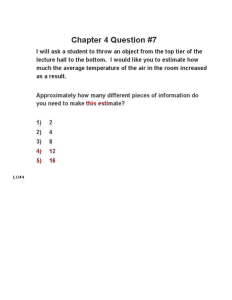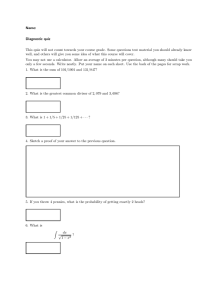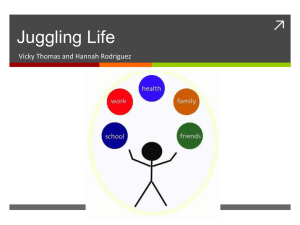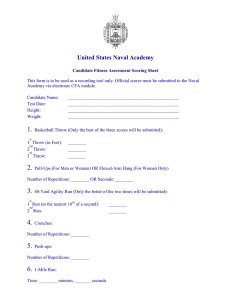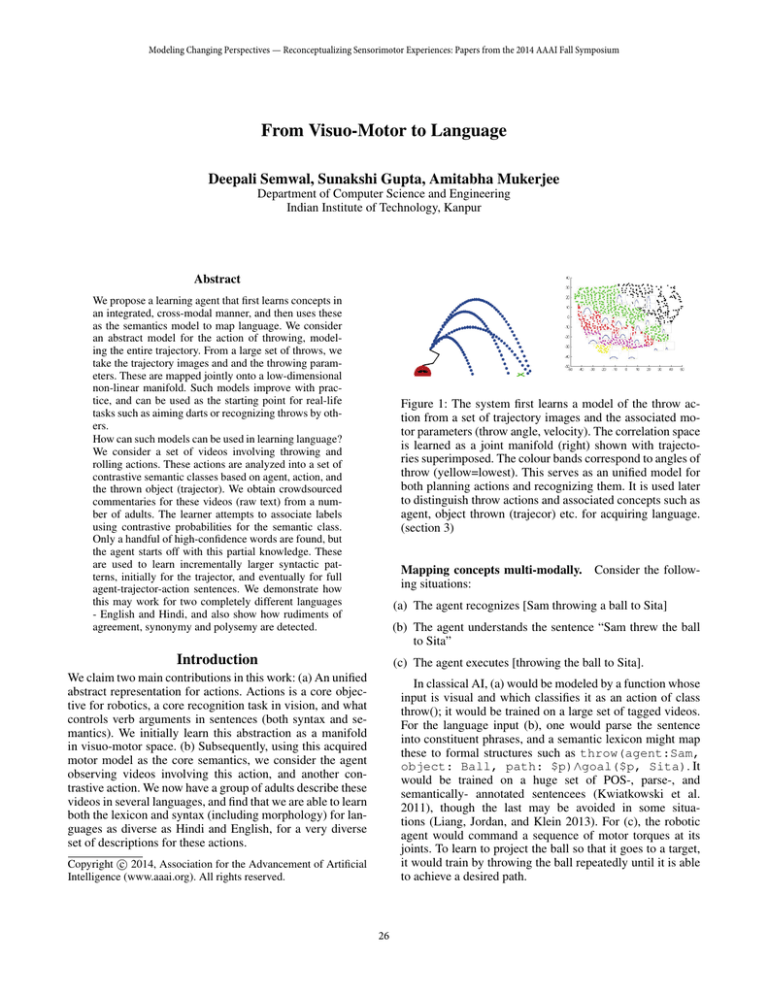
Modeling Changing Perspectives — Reconceptualizing Sensorimotor Experiences: Papers from the 2014 AAAI Fall Symposium
From Visuo-Motor to Language
Deepali Semwal, Sunakshi Gupta, Amitabha Mukerjee
Department of Computer Science and Engineering
Indian Institute of Technology, Kanpur
Abstract
We propose a learning agent that first learns concepts in
an integrated, cross-modal manner, and then uses these
as the semantics model to map language. We consider
an abstract model for the action of throwing, modeling the entire trajectory. From a large set of throws, we
take the trajectory images and and the throwing parameters. These are mapped jointly onto a low-dimensional
non-linear manifold. Such models improve with practice, and can be used as the starting point for real-life
tasks such as aiming darts or recognizing throws by others.
How can such models can be used in learning language?
We consider a set of videos involving throwing and
rolling actions. These actions are analyzed into a set of
contrastive semantic classes based on agent, action, and
the thrown object (trajector). We obtain crowdsourced
commentaries for these videos (raw text) from a number of adults. The learner attempts to associate labels
using contrastive probabilities for the semantic class.
Only a handful of high-confidence words are found, but
the agent starts off with this partial knowledge. These
are used to learn incrementally larger syntactic patterns, initially for the trajector, and eventually for full
agent-trajector-action sentences. We demonstrate how
this may work for two completely different languages
- English and Hindi, and also show how rudiments of
agreement, synonymy and polysemy are detected.
Figure 1: The system first learns a model of the throw action from a set of trajectory images and the associated motor parameters (throw angle, velocity). The correlation space
is learned as a joint manifold (right) shown with trajectories superimposed. The colour bands correspond to angles of
throw (yellow=lowest). This serves as an unified model for
both planning actions and recognizing them. It is used later
to distinguish throw actions and associated concepts such as
agent, object thrown (trajecor) etc. for acquiring language.
(section 3)
Mapping concepts multi-modally. Consider the following situations:
(a) The agent recognizes [Sam throwing a ball to Sita]
(b) The agent understands the sentence “Sam threw the ball
to Sita”
Introduction
(c) The agent executes [throwing the ball to Sita].
We claim two main contributions in this work: (a) An unified
abstract representation for actions. Actions is a core objective for robotics, a core recognition task in vision, and what
controls verb arguments in sentences (both syntax and semantics). We initially learn this abstraction as a manifold
in visuo-motor space. (b) Subsequently, using this acquired
motor model as the core semantics, we consider the agent
observing videos involving this action, and another contrastive action. We now have a group of adults describe these
videos in several languages, and find that we are able to learn
both the lexicon and syntax (including morphology) for languages as diverse as Hindi and English, for a very diverse
set of descriptions for these actions.
In classical AI, (a) would be modeled by a function whose
input is visual and which classifies it as an action of class
throw(); it would be trained on a large set of tagged videos.
For the language input (b), one would parse the sentence
into constituent phrases, and a semantic lexicon might map
these to formal structures such as throw(agent:Sam,
object: Ball, path: $p)∧goal($p, Sita). It
would be trained on a huge set of POS-, parse-, and
semantically- annotated sentencees (Kwiatkowski et al.
2011), though the last may be avoided in some situations (Liang, Jordan, and Klein 2013). For (c), the robotic
agent would command a sequence of motor torques at its
joints. To learn to project the ball so that it goes to a target,
it would train by throwing the ball repeatedly until it is able
to achieve a desired path.
c 2014, Association for the Advancement of Artificial
Copyright Intelligence (www.aaai.org). All rights reserved.
26
This process makes it hard to correlate knowledge between these modalities - e.g. looking at another person
throwing short, it is hard to tell her to throw it higher, say.
It is also inefficient in terms of requiring thrice the circuitry compared to a unified system. Indeed, primate brains
seem to be operating in a more integrated manner. Motor
behaviour invokes visual simulation to enable rapid detection of anomalies, while visual recognition invokes motor
responses to check if they match. Linguistic meaning activates this wide range of modalities (Binder and Desai 2011).
Such a cross-modal model also permits affordance and intentionality judgments, which is a core capability for learning langugae (Rizzolatti and Arbib 1998).
Figure 2: Variations in the manifold according to a) angle of
projection, and b) range. (low values in yellow). For constant
velocity, the range is high towards the left, corresponding to
the “bends” in the coloured bands. This is also the region
around the 45◦ angle of throw (see fig. 1b).
Unified action models as manifolds. The first part of this
work (section 2) is inspired by the observation that each time
the robot throws the ball for motor learning), it also generates a visual trajectory. The motor parameters - torque history, time of release, etc. are correlated with the visual feedback - trajectory, velocities, etc. In fact, both map to the same
low-dimensional non-linear manifold which can be discovered jointly. This is the core idea in the first part of this work.
We note that this approach is more abstract than models that actually attempt to learn throwing actions, e.g. (da
Silva, Konidaris, and Barto 2012; Neumann et al. 2014). Our
model may be thought of as a high-level summary of the
entire space of throws - given any desired trajectory, it can
come up with the motor parameters; given a motor parameter, it can “imaagine” the throw. The model can be applied
to either visual recognition or to motor tasks. It can also be
used to assess other throws, to catch a ball, say, or to guess
the intention of a person throwing something.
ent objects (Steels and Loetzsch 2012) The semantic models learned here are completely unsupervised, whereas other
models with similar motivation often use hand-coded intermediate structures to model the semantics (Roy 2005).
Another distinguishing feature language learning is incremental and does not come to a closure at any point. At every
stage, the learner has only a “best guess” to how a phrase or
sentence may be used. Thus, another name for this approach
may be dynamic NLP. Also, after an initial bootstrapping
phase driven by this multi-modal corpus, learning can continue to be informed by text alone, a process well-known
from the rapid vocabulary growth after the first phase of language acquisition in children (Bloom 2000).
Visuo-motor Pattern Discovery
Learning a few visuo-motor tasks are among our agent’s
very first achievements. Let us consider the act of throwing
a ball. Our learner knows the motor parameters of the throw
as it is being thrown - here we focus not on the sequence of
motor torques, but just the angle and velocity at the point of
release.
Each trajectory gives us an image (fig. 1). Given a dataset
of images X = x1 ...xn , drawn from a space I of all possible trajectory images. Each image has 100×100 pixels, i.e.
4
I ⊂ R10 . Though the set of possible images is enormous, if
we assign pixels randomly, the probability that the resulting
image will be a [throw] trajectory is practically zero. Thus,
the subspace of [throw] images I is a vanishingly small part
of all possible images.
Next we would like to ask what types of changes can we
make to an image while remaining within this subspace? In
fact, since each throw varies only on the parameters (θ, v),
there are only two ways in which we can modify the images while remaining locally within the subspace I of throw
trajectory images. This is the dimensionality of the local
tangent space at any point, and by stitching up these tangent spaces we can model the entire subspace as a nonlinear manifold of the same intrinsic dimensionality. The
struture of this image manifold exactly mimics the structure of the motor parameters (the motor manifold). They
can be mapped to a single joint manifold (Davenport et al.
2010), which can be discovered using standard non-linear
Bootstrapping a lexicon and syntax. For the language
task (section 3), we cosider the system which already has
a rudimentary model for [throw], being exposed to a set of
narratives while observing different instances of throwing.
The narratives are crowdsourced from speakers for a set of
synthetic videos which have different actions (throw or roll),
agents (“dome” or “daisy” - male/female), thrown object or
trajector (ball or square), colour of trajector (red or blue) and
path (on target, or short, or long). We work with transcribed
text, and not with direct speech, so we are assuming that our
agent is able to isolate words in the input.
An important aspect of working with crowdsourced data
is that descriptions of the same action vary widely. For the
very beginning learner, we need a more coherent input, and
we first identify a small coherent subset (called the family
lect) on which initial learning is done. This is then extended
to the remaining narratives (the multi-lect).
The approach learns fragments of the linguistic discourse
incrementally. Starting with a few high-confidence words
(fig. 4), it uses these to learn larger phrases, interleaving the
partial syntax with the semantic knowledge to build larger
syntactic patterns.
This partial-analysis based approach is substantially
different from other attempts at grounded modeling in
NLP (Madden, Hoen, and Dominey 2010), (Kwiatkowski
et al. 2011), (Nayak and Mukerjee 2012). It is also different from attempts that learn only nouns and their refer-
27
Table 1: Sum Absolute Error (Velocity) falls as N increases
Figure 3: Throwing darts. a) Two trajectores that hit the
board near the middle. b) A band for “good throws” in the
2D manifold of projectile images, with a tighter curve for
the “best” throws. This model can now be used to make suggestions such as “throw it higher”.
Figure 4: High confidence lexeme discovery : Contrastive
scores and dominance ratio for top lexemes in. Highlighted
squares show high-confidence lexemes (ratio more than
twice)
dimensionality reduction algorithms such as ISOMAP. In
fig. 2, we show the resulting manifold obtained using a hausdorff distance metric (Huttenlocher, Klanderman, and Rucklidge 1993): (h(A, B) = maxa∈A minb∈B ka − bk, symmetrized).
The same idea can be used to find correlations in any system involving a motion or a change of initial conditions, using algorithm 1:
Barto 2012).
As in those studies, our model also ignores lateral deviations, the and we consider successful trajectories as those
that intersect the dartboard near its center (fig. 3a). In order
to throw the dart, the system focuses on a “good zone” in
the latent space (central band in fig. 3b), where it focuses on
throws that are more nearly orthogonal to the board at contact (short curved axis). Of course, actual task performance
will improve with experience (more data points in the vicinity of the goal), resulting in better performance. Such an abstract model only provides a starting point.
Bootstrapping Language
In order to learn language, we create a set of 15 situations
involving the actions [throw] and [roll] (one of the agents is
shown in fig. 1a). The videos of these actions are then put
up on our website. Largely students on the campus network
contributed commentaries. We obtain 18 Hindi and 11 English transcribed narratives.
The compiled commentaries vary widely in lexical and
constructional choices - e.g. one subject may say "daisy
throws a blue square", whereas another describes the same
video as "now daisy threw the blue box which fell right
on the mark". Differences in linguistic focus cause wide
changes in lexical units and constructions. As described earlier, we first select a coherent subset of narratives - those that
have a more consistent vocabulary, and identify these as the
family lect.
The abstract motor model already learned for throw is
used as a classifier manifold - if the action falls in this
class (is modelable in terms of a local neighbourhood), it is
marked as a throw. The other class, roll, is not implemented
specifically, but taken to be the negation. In this case, the
two classes can be separated quite easily. In addition to the
This is a generic algorithm for discovering patterns in
visuo-motor activity. Initially, its estimate of how to achieve
a throw are very bad, but they improve with experience. We
model this process in table 1 - as the number of inputs N increases, the error in predicting a throw decreases - at N=100,
the error is nearly twice that at N=1000.
Using the model to throw darts
The visuo-motor manifold model developed here is not taskspecific, but can be applied for many tasks involving projectile motion, catching a ball, throwing at a basket, darts,
tennis, etc. As an example we can consider darts, a problem often addressed in the psychology and robotics literature (Müller and Sternad 2009; da Silva, Konidaris, and
28
Table 2: Initial constructions learned from the trajector delimited strings
Table 3: Syntax for trajector - iteration 1, Family-lec
action being recognized, we also assume that the system can
the agent who throws, the object thrown, and its attributes
- shape (square vs circle), and colour (red vs blue). These
contrasts - e.g. the two agents - [Dome] with a moustache
(fig. 1, male), and [Daisy] with a ponytail) - are crucial to
word learning. [Note: we use square brackets to indicate
a concept, the semantic pole of a linguistic symbol) This
contrastive approach has been suggested as a possible strategy applied by child learners (Markman 1990). Given two
contrasting concepts c1 , c2 , we compute the empirical joint
probabilities of word (or later, n-gram) ωi and concept c1 , c2 ,
and compute their contrast score:
patterns which can be used to induce broader regularities.
We compare two available unsupervised grammar induction
systems - Fast unsupervised incremental parsing (Seginer
2007) and ADIOS(Solan et al. 2005); results shown here
adopt the latter because of a more explicit handling of discovered lexical classes.
The initial patterns learned for the trajector in this manner
are shown in Table 2. These are generalized using the
phrase substitution process to yield the new lexeme include
graphicsinline2(ball), [ball], in Hindi and “blue” in English
(Table. 3). This is done based on the family-lect (Figure
4), and the filtered sub-corpus is used to learn patterns and
equivalence classes.
Sωi ,c1 =
P (ωi , c1 )
P (ωi , c2 )
The system now knows patterns for [red square], say, and
it now pays attention to situations where the pattern is almost present, except for a single substitution. It can look
into a the other semantic classes as well, (e.g. [blue square],
[red ball]). In most of these instances (Fig. 4) we already
have partial evidence for these units from their contrastive
scores. Now if we discover new substitution phrases p1 in
the position of p0, referring to a concept in the same semantic class (e.g. [ball] for [square]), and if p1 is already
partially acceptable for [ball] based on contrastive probability, then p1 becomes an acceptable label for this semantic
concept. This process iterates - new lexemes are used to induce new patterns, and then further new lexemes, until the
patterns stabilize. This is then extended to the entire corpus
beyond the small family lect; results are shown in Table 4.
The table captures a reasonable diversity of Noun Phrase
patterns describing coloured objects. Note that words like
“red” and “ball” have also become conventionalized in
Hindi. We also observe that the token niley appears in the
4-word pattern niley rang kaa chaukor and is highly confident even from a single occurrence; this reflects the fast
mapping process observed in child language acquisition after the initial grounding phase (Bloom 2000). As the iteration progresses, these patterns are used for further enhancing
the learners inventory of partial grammar.
We also compare the corpus of narratives here with that
from a larger unannotated corpus (Brown Corpus for English
and the CIIL/IITB Corpus for Hindi). We look for words that
are more frequent in the domain input than in a general situation. This rules out many frequent words like a, and, the for
[is, of] (Hindi). The small set of high conEnglish, and
fidence words - whose contrastive probability is more than
twice the next best match - are highlighted in (Fig. 4).
Interleaving of Word / Syntax learning
Once the system has a few grounded lexemes, we proceed
to discovering syntactic constructions. At the start, we try
to learn the structure of small contiguous elements. One assumption we use here is that concepts that are very tightly
bound (e.g. object and its colour) are also likely to appear
in close proximity in the text (Markman 1990). Another assumption (often called syntactic bootstrapping), is used for
mapping new phrases and creating equivalence classes or
contextual synonyms. This says that given a syntactic pattern, if phrase p1 appears in place of a known phrase p0, and
if this substitution is otherwise improbable (e.g. the phrase is
quite long), then p0, p1 are synonyms (if in the same semantic class) or they are in the same syntactic lexical category.
We find that one type of trajector (e.g. “ball”) and its
colour attribute (e.g. “lAl”, [red]) have been recognized.
So the agent pays more attention to situations where these
words appear. Computationally this is modelled by trying
to find patterns among the strings starting and ending with
(delimited by) one of these high-confidence labels (e.g. “red
coloured ball”). This delimited corpus consistes of strings
related to a known trajector-attribute complex. Within these
tight fragments, we show that standard grammar induction procedures are able to discover preliminary word-order
Verb phrases and sentence syntax
Having learned the syntax for a trajector, this part of the input is now known with some confidence, and the learner can
venture out to relate the agent to the action and path. In this
study, we failed to find any high-confidence lexemes related
to path, hence we were not able to bootstrap that aspect. In
the following we restrict ourselves to patterns for the semantic classes [agent], [action], [trajector].
At this stage, the agent notes that many of the words seem
29
Figure 5: Verb learning. Recomputed contrast scores after
morphological clustering. Note that “threw” now appears as
a high-confidence label.
Table 4: Learned constructions pertaining to trajectors : The
coloured units are the initially grounded lexemes
Table 6: Sentence syntax discovered - iteration 1 - FL
used to obtain a filtered corpus. To simplify the task of discovering verb phrase syntax, the known trajector syntax (table 4) is considered as a unit (denoted as [TRJ], and the
concept of agent ([daisy] or [dome]) is denoted [AGT]. Results of initial patterns, obtained based on the two known action lexemes, are shown in Table 5. Note that pattern matching with Adios now discovers the class a, the as equivalence
class E23 (replaced hereon).
Next, we interleave this syntactic discovery with lexical discovery, permitting also bigram substitutions. Thus
“threw” and “rolled” are found to be substitutable by has
thrown, is throwing; and has slid respectively. This gives us
the more general results of Table 6. Again the system iterates
over the corpus till the discovery of new patterns converges
(Table 7) results. An interesting observation is that the Hindi
(nilaa
data finds a phrase in the TRJ position chaukor) [blue square]. This had not been learned in the trajector
iteration, since nilaa was less frequent.
Thus we see that with this approach we are able to acquire
several significant patterns. These patterns apply to only a
single action input, and for a very limited set of other participants. But it would be reasonable to say that the agent
may observer similar structures elsewhere - e.g. in a context involving hitting, say, if we have the sentence “Daisy hit
Dome” then the agent may use the syntax of [AGT] [verb]
[TRJ] to extend to this context and guess that “hit” may be
a verb and “Dome” the object of this action (which it knows
Table 5: Initially acquired sentence constructions
rather similar (e.g. “sarkAyA”, “sarkAyI” (H); or “throwing”, “thrown” (E)). A text-based morphological similarity
analysis is reveals several clusters with alterations at the end
of words (Fig. 5). To quantify this aspect, we consider normalised Levenshtein distance and perform a morphological
similarity analysis. Since our input is text, we limit ourselves
to analysis based on the alphabetic patterns as opposed to
phonemic maps. Similar words are clustered using a normalized similarity index .Thus we have twelve type instances of
-aa) - (
ii) , and seven types for (
-aa) - ( (
e). We find that these variants - e.g. “sarkaayaa”, “sarkaayii”
- appear in the same syntactic and semantic context. These
clusters are now used to further strengthen the lexeme and
action association.
Again, we use an iterative process, starting with grounded
unigrams, moving a level up to learn simple word-order
patterns, learning alternations and lexical classes through
phrase substitution, and so on to acquire a richer lexicon and
syntax. The learner has the concept of agent and has associated the words “daisy” and “dome”. One action word is
known for both Hindi and English (Fig. 5), and these are
30
Will the approach scale to other actions? The first task is
to demonstrate scalability, by including actions other than
[throw]. One of our main strengths is that neither the visuomotor nor the linguistic components had any kind of annotation, so the training dataset needed for this should be relatively easy to generate compared to treebanks and semantically annotated data.
Another problem would be to use the motor model to
guess intentions and formulate sentences such as “try to
throw a little higher”. In the present work, the intention can
plausibly be captured, but we are not able to handle the linguistic part yet. This is because the last part of the sentences
in these narratives - those that encode the quality of the
throws (“overshot the mark”, “hit the target exactly”) exhibit
too much variation to be learned from this small corpus, but
it should be possible to do this with a larger dataset.
A third area would be to extend this work into metaphor,
e.g. sentences such as (d) “Sam threw the searchlight beam
at the roof.”, or (e) "Sam threw her a searching look." These
can be related to the motor model of [throw], as a motion.
But these are typically never encountered in a grounded
manner, but quite often in language-only input. Linking this
language input to the existing grounded models would open
up new vistas for concept and language discovery.
References
Binder, J. R., and Desai, R. H. 2011. The neurobiology of
semantic memory. Trends in cognitive sciences 15(11):527–
536.
Bloom, P. 2000. How Children Learn the Meaning of Words.
MIT Press.
da Silva, B. C.; Konidaris, G.; and Barto, A. G. 2012. Learning parameterized skills. In Proc. ICML.
Davenport, M. A.; Hegde, C.; Duarte, M. F.; and Baraniuk,
R. G. 2010. High-dimensional data fusion via joint manifold learning. In AAAI Fall 2010 Symposium on Manifold
Learning, Arlington, VA.
Huttenlocher, D. P.; Klanderman, G. A.; and Rucklidge,
W. J. 1993. Comparing images using the hausdorff distance.
IEEE PAMI 15(9):850–863.
Kwiatkowski, T.; Zettlemoyer, L.; Goldwater, S.; and Steedman, M. 2011. Lexical generalization in ccg grammar induction for semantic parsing. In Proc. EMNLP, 1512–1523.
Liang, P.; Jordan, M. I.; and Klein, D. 2013. Learning
dependency-based compositional semantics. Computational
Linguistics 39(2):389–446.
Madden, C.; Hoen, M.; and Dominey, P. 2010. A cognitive
neuroscience perspective on embodied language for humanrobot cooperation. Brain and Language 112(3):180–188.
Markman, E. M. 1990. Constraints children place on word
meanings. Cognitive Science 14(1):57–77.
Müller, H., and Sternad, D. 2009. Motor learning: changes
in the structure of variability in a redundant task. In Progress
in motor control. 439–456.
Nayak, S., and Mukerjee, A. 2012. Grounded language acquisition: A minimal commitment approach. In Proc. COLING 2012, 2059–76.
Table 7: Learned constructions over trajector phrases, The
coloured units are the initially grounded lexemes
from the semantics). Thus, once a few patterns are known,
it becomes easier to learn more and more patterns, which is
the fast mapping stage we have commented upon earlier.
Note that our lexical categories are not necessarily the
same as that of a linguist. But those categories are often
a matter of fierce contention, and most human language
users are blissfully unaware of these and perhaps our system can also do quite well without quite mastering these. At
the same time, most of the structures (e.g. Adj-N (red ball,
laal chaukor),Art-N (E23 ball), etc are indeed discovered.
It also discovers agreement between the the unit “chaukor”,
[square, M] and verbs ending in -aa. However, following
the usage-based approach (Tomasello and Tomasello 2009),
we would be inclined to view these constructions as reducing the description length needed to code for the strings arising in this context.
Conclusion
The above analysis provides a proof-of-concept that a system starting with very few priors can, a) combine motor,
visual (and possibly other modalities) into an integrated
model, and b) use this rudimentary concept knowledge to
bootstrap language. We also note that such a system can
then learn further refinements to this concept space using
language alone.
We believe that this novel idea of linking modalities will
open up a number of new areas in AI. We mention three
possible directions.
31
Neumann, G.; Daniel, C.; Paraschos, A.; Kupcsik, A.; and
Peters, J. 2014. Learning modular policies for robotics.
Frontiers in Computational Neuroscience 8:62.
Rizzolatti, G., and Arbib, M. A. 1998. Language within our
grasp. Trends in neurosciences 21(5):188–194.
Roy, D. 2005. Semiotic schemas: A framework for grounding language in action and perception. Artificial Intelligence
167(1-2):170–205.
Seginer, Y. 2007. Fast unsupervised incremental parsing. In
ACL Ann. Meet, volume 45, 384.
Solan, Z.; Horn, D.; Ruppin, E.; and Edelman, S. 2005.
Unsupervised learning of natural languages.
PNAS
102(33):11629–34.
Steels, L., and Loetzsch, M. 2012. The grounded naming
game. Experiments in Cultural Language Evolution. Amsterdam: John Benjamins.
Tomasello, M., and Tomasello, M. 2009. Constructing a
language: A usage-based theory of language acquisition.
Harvard University Press.
32

